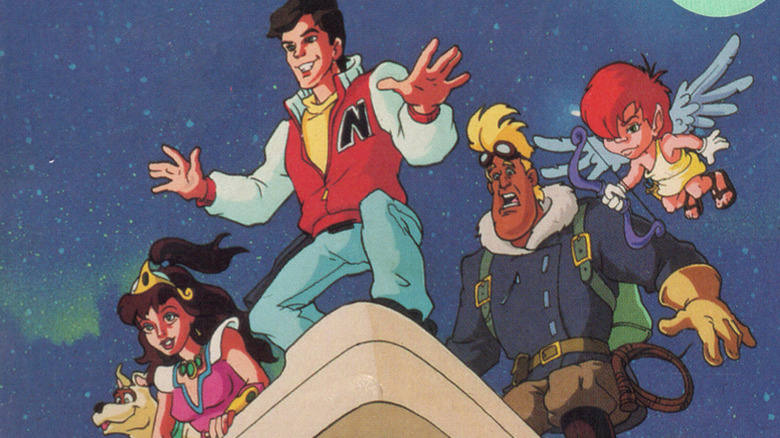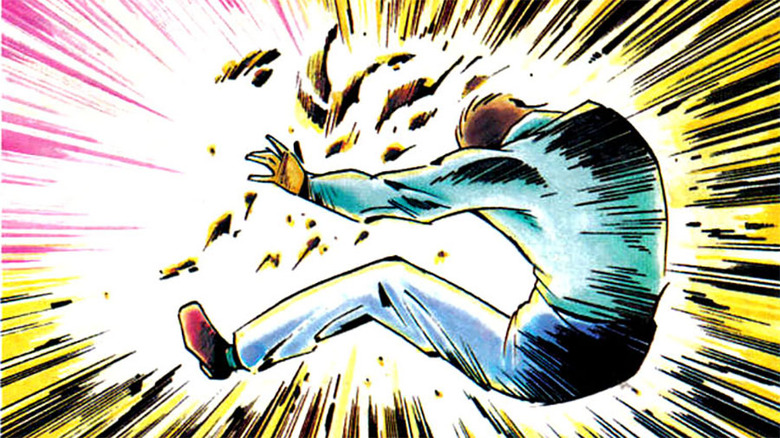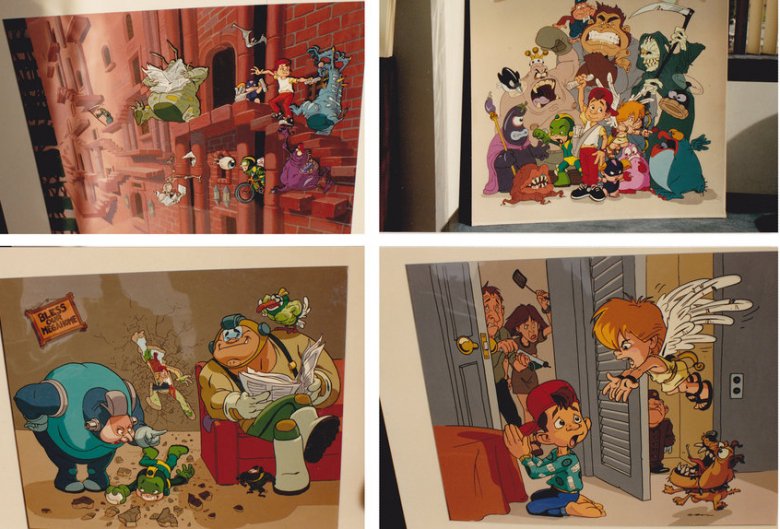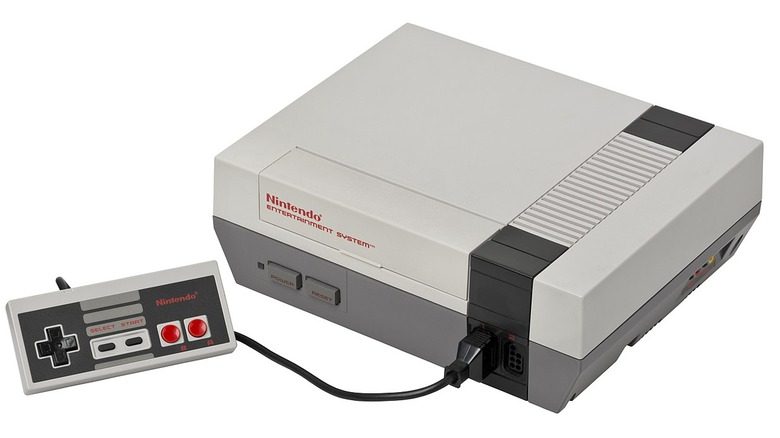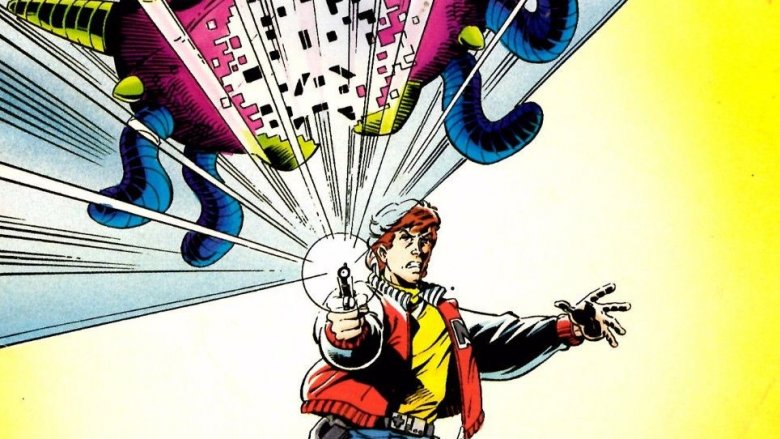The Untold Truth Of Captain N: The Game Master
We may receive a commission on purchases made from links.
If you were a video-game obsessed kid back in the late '80s and early '90s, you probably only turned your Nintendo off for a few of reasons: you either needed to go to school, you were heading out to pick up a new game, or you wanted to watch the latest episode of Captain N: The Game Master.
Captain N may not have had top-notch writing or dazzling animation, but its premise — a skilled Nintendo player gets sucked into his TV and ends up in Videoland, where he fights alongside and against some of the biggest stars in gaming — ensured that the show would become a cult classic. But don't take our word for it: read on, and remember what made Captain N one of the weirdest, elaborate, and most memorable Nintendo commercials — ahem, cartoons — ever made.
The real Captain Nintendo
You probably know Captain N best as the star of his own cartoon, but the character didn't debut on television. He made his first appearance in Nintendo Power, a magazine designed to hype and sell Nintendo products by giving readers pages crammed full of hints, game reviews, comics, and other Nintendo-related material.
Inspired by the superhero comics he read as a kid, Nintendo Power editor Randy Studdard created a character called Captain Nintendo that he imagined would serve as a mascot for the company. As in the cartoon, Studdard's Captain Nintendo is a normal human being who ends up squaring off with video game characters, including Metroid's big bad, Mother Brain. In the cartoon, however, Kevin "Captain N" Keene is a regular American teenager who travels into the video game world by teleporting through his television. Studdard's Captain Nintendo works at Nintendo as a technician and gets super powers after his crush spills coffee on a pile of microchips, inadvertently bringing Mother Brain to life.
The first (and only) Captain Nintendo story was published in two parts in the November/December 1988 and January/February 1989 issues of Nintendo Power. After Studdard's boss decided to axe the feature, Studdard pitched the character (and a potential animated series) to a member of Nintendo's marketing department, who liked the idea — but, Studdard claims, didn't want to pay him for it. Studdard continued to answer Nintendo Power fan mail under the guise of Captain Nintendo and eventually adopted the nickname himself, but he didn't have anything to do with the resulting cartoon. Judging by his written account, Studdard is still pretty bitter about the whole thing.
Out with Buddy Boy, in with Captain N
Studdard wasn't the only person developing a crossover series starring well-known video game characters. Around the same time that Captain Nintendo was gracing the pages of Nintendo Power, DiC Entertainment, the company behind animated hits like Inspector Gadget, The Real Ghostbusters, Dennis the Menace, and Captain Planet, was hard at work on its own Nintendo-themed series.
Originally, the cartoon was going to be based on the Atari game Paperboy, although legal complications forced DiC and Nintendo to rename the character Buddy Boy, and would've seen the bike-riding teen team up with characters from a myriad of different games. Accomplished DiC artist Fil Barlow (whose Patreon page is filled with art from his many animation projects) provided character designs for the proposed series, which included future Captain N cast members like Kid Icarus' Pit and Eggplant Wizard and Punch-Out!!'s King Hippo. Mega Man, who also joined Captain N, originally came with an entire Mega-family, including Megamum, Megadad, Megabird, and Megarat. Sadly, the Megaclan didn't survive, but most of Barlow's other designs did, although DiC tweaked the art style for the final product.
According to Barlow, the characters would've crossed between the Game World and the real world via a portal in Buddy Boy's closet, with the conceit that "reality is as addictive to Game World characters as games are to us." Unfortunately, DiC fired Barlow shortly after he made the drawings, and combined Barlow and Studdard's concepts to create Captain N.
The console that must not be named
As Studdard tells the story, the entire reason why Captain Nintendo was created in the first place was to help sell Nintendo products and other video games, and yet the word Nintendo is never uttered on the final show. Even the name of the series was changed from Captain Nintendo: The Game Master to the now-familiar Captain N early in production.
According to series writer Jeffrey Scott, who did an interview in 2002 with the The Unofficial Captain N Home Page, the Nintendo's absence from the cartoon wasn't a creative decision, but a legal one. Throughout the '80s, most kids' cartoons were created to help sell toys — in fact, series like Transformers and G.I. Joe started as toy lines, and only became animated series later. By the time that Captain N debuted, parents were growing concerned that children's entertainment was becoming a series of thinly-masked commercials. So was the United States government.
In 1990, the Congress passed the Children's Television Act, which limited the amount of airtime that could be devoted to commercials during kid-oriented programming and encouraged networks to air more beneficial or educational programming.
Captain N debuted in September, 1989, a year before the Children's Television Act was signed into law, but by that point the writing was already on the wall. The House had passed its version of the CTA in April, 1989, a few months before Captain N's premiere, and public opinion was decidedly on the parents' side. In that environment, using Nintendo's name made DiC nervous, and the studio decided not to take the risk. "'N' was as close as we could get," Scott says.
For the fans, but not by the fans
While many of Captain N's characters seem familiar, many of them don't really look or act much like their in-game counterparts. Pit is called Kid Icarus, which is actually the name of the game that he appears in. Similarly, Mother Brain lives on an asteroid named "Metroid," not the planet Zebes. Castlevania's hero, Simon Belmont, is a vain and egotistical jerk, while Alucard, Dracula's son, is depicted on the show as a skateboard-riding wiseass wearing bat-shaped sunglasses.
There's a very good reason for these discrepancies: Captain N was made by animation industry professionals, not video game fans. Jeffrey Scott, who wrote every episode of Captain N's first season, only played a tiny bit of each game before penning an episode. Artist Fil Barlow only had the games themselves to use for reference. Nintendo didn't provide manuals, backstory, or any extra information. Matt Hill, who voiced Captain N, told Rolling Stone that he hasn't played a video game since Pong. Ian James Corlett, who played Mega Man's arch-nemesis Dr. Wiley, admits that the actors basically made the characters up based on their animated designs.
When it came to continuity issues, Nintendo wasn't much help either. For example, on Captain N, Mega Man is green, not blue. Barlow says that this was due to limited experience, a faulty recollection, and maybe even just a crappy television.
"I played the game for [one] night on a small TV," Barlow says. "I had to rely on memory when I did the color for this pitch art." He further clarified on his Deviant Art page that he may have misremembered the details of the miscolored Mega Man, adding, "I wasn't the colorist on this art, that was handled by someone else. So the Megaman colored green thing wasn't my call."
Regardless of who made the coloring error, it was never corrected, neither by other people who had played the game nor by "executives from DiC and Nintendo who were supposed to at least know their own franchise."
Princess Lana's pen-and-ink rival
Most early Nintendo games don't have much going on in the way of plot, but that didn't stop Valiant Comics, the home of '90s comic shop mainstays like X-O Manowar and Harbinger, from publishing a series of comics known collectively as the Nintendo Comics System. Two of Valiant's Nintendo comics, Super Mario Bros. and The Legend of Zelda, were hokey spin-offs of the games' animated series. Game Boy was a weird, psychedelic reimagining of Super Mario Land in which characters from the Game Boy game invaded the real-world and caused absolute (and not at all child-friendly) havoc.
In terms of tone, Valiant's Captain N adaptation was somewhere in between. On one hand, the comic has the same silly premise as the television show, and it's filled with groan-worthy puns. On the other, it doesn't have much to do with the cartoon. The stories are much more faithful to Captain N's source material, the action scenes are remarkably well-drawn, and the characters gain some much needed depth in the transition from screen to page. The cast is different, too. While Captain N the cartoon featured a number of characters owned by non-Nintendo companies, Valiant only had the rights to Nintendo's own characters. That meant that Mega Man — a Capcom character — and Simon Belmont — a Konami creation — were gone. The N Team needed some fleshing out.
So, Valiant introduced Samus, Metroid's hero and Mother Brain's arch-nemesis, into the mix. She changes everything. As a rowdy, confident, and extremely capable warrior, Samus interjects Captain N with some much-needed energy. Even better, Samus is presented as Kevin's second love interest, transforming the dull romance between Captain N and Princess Lana (an original character) into a vibrant and compelling triangle.
It works really, really well. So, why didn't Samus show up in the main series? As writer Jeffrey Scott explains, "Never heard of her. That could by why." Wellp.
The phantom episode
Captain N: The Game Master made its way to DVD in 2007 in a boxed set from Shout Factory, but the so-called "complete series" isn't actually complete at all. For one, the third and final season of the show is entirely missing. See, while Captain N's first two seasons were comprised of 13 full-length 22-minute episodes, the third season's episodes are only 11 minutes long and were shipped to networks along with episodes of Super Mario World. According to Brian Ward, Shout Factory's product manager, Captain N & the New Super Mario World is technically a separate series.
As a result, publishing the third season required a totally different license, and securing it was an uphill battle — though it did eventually get a 2007 DVD release. The problem, according to Ward, is that Nintendo isn't exactly thrilled to revisit these old cartoon series, which were made when Nintendo of America was more focused on marketing, and wasn't as closely aligned with Nintendo of Japan as it is now.
But that's not all. "When Mother Brain Rules," a clip show episode, isn't on the DVD either — although the reason for that omission is much more mysterious: according to DiC, the episode doesn't exist. Copies of the episode can be found on YouTube, so it clearly aired. And yet, DiC claims to have no master tape, and the episode is missing from the company's records. Other than the grainy bootlegs, there's no proof that the episode was ever made. Ward's best guess is that NBC edited the episode on its own from pre-existing episodes — after all, as a clip show, there's not any new material — and aired "When Mother Brain Rules" as a season finale, but that's just a hunch. Nobody knows for sure where the episode came from.
An A-list soundtrack on a B-grade show
Say what you will about Captain N's writing or the quality of its animation, but there's one thing that you can't deny: it's got a impressive soundtrack. During Captain N's first season, covers of well-known pop tunes played over sections of each episode, usually (but not always) relating to the episode's theme.
These aren't minor hits, either. Captain N included renditions of some of the most popular songs of all time. N Team's trip to Castlevania in the episode "The Most Dangerous Game Master" is accompanied by Michael Jackson's "Thriller." When Kevin teams up with The Adventures of Bayou Billy's eponymous hero, Creedence Clearwater Revival's "Born on the Bayou" plays. Kenny Loggins' "Danger Zone" is featured in two Mega Man-centric episodes, "Mega Trouble for Megaland" and "Happy Birthday, Megaman." That's just the tip of the iceberg. Covers of songs by Billy Idol, Stevie Wonder, Bob Seger, James Brown, and even famous film composer Ennio Morricone all popped up during Captain N's adventures.
In fact, those songs are one of the reasons why it took 17 years for Captain N to make its way to DVD. As Shout Factory's Brian Ward explains, in the '80s, animation companies didn't usually plan for home video re-releases — remember, this was back before video streaming and DVD boxed sets were a thing— and Captain N's producers didn't bother to nail down the long-term music rights. Unfortunately, re-securing permission to use those covers was too expensive for DiC and Shout Factory, and all of the first season episodes needed to be re-edited with different, copyright friendly soundtracks before the DVDs could make their way to the the market.
Feed me, Samus!
At the time of its creation, Captain N didn't have an all-star cast, but it did launch the careers of some very well-known voice actors. Matt Hill, who'd later go on to play Ed in Ed, Edd n Eddy and Kira Yamato in Mobile Suit Gundam Seed, broke in as Captain N himself, his very first role. Alessandro Juliani, who went on to portray Battlestar Galactica's Lieutenant Felix Gaeta in addition to playing a number of live-action and voice-over roles, voiced Kid Icarus when he was still a teenager.
If you're a fan of cult musicals, however, listen carefully. Mother Brain should sound very, very familiar. See, Captain N's big bad was played by none other than Levi Stubbs, who also provided the voice for Little Shop of Horrors' villainous plant, Audrey II. Of course, for Stubbs, voice acting was just a side gig. The musician is better known as the lead singer for the pioneering R&B group The Four Tops. Over the course of his 46-year stint with the band, Stubs provided vocals for 20 top-40 singles, including "I Can't Help Myself (Sugar Pie, Honey Bunch)" and "Baby I Need Your Loving," and was inducted alongside his bandmates to the Rock and Roll Hall of Fame in 1990.
While Stubbs was the most famous member of The Four Tops — the Temptations' Dennis Edwards called him "the greatest lead singer ever" — he was a generous and open-hearted performer who took great pains to make sure that the rest of the band got equal credit. Stubbs even turned down a starring role in Lady Sings the Blues so that he wouldn't overshadow his fellow musicians.
Bo knows... Nintendo?
Captain N is all about a kid who gets to meet fictional video game characters, but what does that mean for real-life people who happen to make video game appearances? It's not a problem. Kevin gets to meet them too — or, at least, their video game incarnations.
That's got to be the justification for shoehorning Bo Jackson, the hybrid football and baseball star who became the first person to play in the All-Star games for two major American sports, into Captain N. Jackson appears in the third season episode "Battle of the Baseball Know-It-Alls," a spin-off of Data East's NES game Bo Jackson Baseball. True to that title, Jackson spends the episode on the diamond, not behind the gridiron, but he does get to fight some sentient baseball equipment and square off against the Baseball Card King, a character created specifically for the series.
Similarly, the three-time NBA Most Valuable Player award winner Larry Bird appeared in season three's "Pursuit of the Magic Hoop" courtesy of Electronic Arts' Jordan vs. Bird: One on One. In that episode, Bird helps N Team and a young inventor named Hoopless regain control of a rampaging robot with his championship-winning basketball skills. While Captain N's Bo Jackson and Larry Bird both resemble their real-life counterparts, the episodes' end credits reveal that neither athlete voiced themselves in the series. Its unclear what influence they had — if any — over their animated incarnations.
There's shoddy animation, and then there's this
Animation-wise, Captain N episodes can get pretty dicey. The series used a different animation studio every season, and by the time that season three rolled around, the budget had been slashed to the point where NBC's cost-cutting measures were very, very noticeable. Still, that doesn't explain exactly how the series' second episode, "How's Bayou," made it on the air before the animation was even finished.
On its initial airing, "How's Bayou" was notably incomplete. Backgrounds are missing. So are some lines and action beats. Some of the music sounds like it's a temp track. It's obviously not finished. According to fans, that version of "How's Bayou" only aired once. After "How's Bayou" premiered in September 16, 1989, it was replaced during the rerun cycle by a cleaned-up and much improved version of the episode, which reintroduced the missing material, added a few special effects, and allegedly contained an entirely different cover of Creedence Clearwater Revival's "Born on the Bayou." For all intents and purposes, the rough-draft edition of the episode was gone for good.
And then, the DVDs came out. For some reason, the Captain N Complete Series DVD set contains the original, incomplete version of "How's Bayou," and not the better-known, fixed edition. Well, it's almost the original edition, anyway: like all of the other pop songs on Captain N, "Born on the Bayou" has been replaced on the DVD with generic instrumental music. That means that there are actually three separate versions of "How's Bayou" out there, and not a single one of them explains exactly why an incomplete episode aired in the first place. It's N-explicable.

